An Improved Heating System with Waste Pressure Utilization in a Combined Heat and Power Unit
Abstract
:1. Introduction
2. Concept Proposal
3. Reference CHP Unit
4. Thermodynamic Analysis
4.1. Energy Evaluation Method
4.2. Simulation Model
5. Results and Discussion
5.1. Basic Analysis
5.2. Sensitivity Analysis
6. Conclusions
Author Contributions
Acknowledgments
Conflicts of Interest
Nomenclature
| Q | heat (MW) |
| m | flow rate (t/h) |
| h | specific enthalpy (kJ/kg) |
| P | generation power (MW) |
| E | exergy (MW) |
| Greek Symbols: | |
| δ | relative error |
| η | efficiency |
| Subscripts: | |
| tp | thermal power |
| 0 | initial |
| b | boiler |
| e | electricity |
| fw | feed-water |
| rh | reheated |
| en | Energy |
| ex | Exergy |
| p | pipe/practical |
| c | cold/calculated |
References
- Elmegaard, B.; Ommen, T.S.; Markussen, M.; Iversen, J. Integration of space heating and hot water supply in low temperature district heating. Energy Build. 2016, 124, 255–264. [Google Scholar] [CrossRef] [Green Version]
- Athawale, R.; Felder, F.A.; Goldman, L.A. Do combined heat and power plants perform? Case study of publicly funded projects in New York. Energy Policy 2016, 97, 618–627. [Google Scholar] [CrossRef]
- Ghorbani, N. Combined heat and power economic dispatch using exchange market algorithm. Int. J. Electr. Power 2016, 82, 58–66. [Google Scholar] [CrossRef]
- Zhang, G.; Cao, Y.; Cao, Y.; Li, D.; Wang, L. Optimal energy management for microgrids with combined heat and power (CHP) generation, energy storages, and renewable energy sources. Energies 2017, 10, 1288. [Google Scholar] [CrossRef]
- Mago, P.J.; Smith, A.D. Evaluation of the potential emissions reductions from the use of CHP systems in different commercial buildings. Build. Environ. 2012, 53, 74–82. [Google Scholar] [CrossRef]
- Tsai, W. Regulatory Compliance and Environmental Benefit Analysis of Combined Heat and Power (CHP) Systems in Taiwan. Energies 2013, 6, 557–565. [Google Scholar] [CrossRef] [Green Version]
- Comodi, G.; Rossi, M. Energy versus economic effectiveness in CHP (combined heat and power) applications: Investigation on the critical role of commodities price, taxation and power grid mix efficiency. Energy 2016, 109, 124–136. [Google Scholar] [CrossRef]
- Sartor, K. Simulation models to size and retrofit district heating systems. Energies 2017, 10, 2027. [Google Scholar] [CrossRef]
- Zhang, J.; Cho, H.; Knizley, A. Evaluation of financial incentives for combined heat and power (CHP) systems in U.S. regions. Renew. Sustain. Energy Rev. 2016, 59, 738–762. [Google Scholar] [CrossRef]
- Waqar, A.; Tanveer, M.S.; Ahmad, J.; Aamir, M.; Yaqoob, M.; Anwar, F. Multi-objective analysis of a CHP plant integrated microgrid in Pakistan. Energies 2017, 10, 1625. [Google Scholar] [CrossRef]
- Guo, Y.; Zhang, X.; Yang, L.; Xu, C.; Du, X. The heat transfer of microencapsulated phase change material slurry and its thermal energy storage performance of combined heat and power generating units. Energies 2017, 10, 1662. [Google Scholar] [CrossRef]
- Sun, S. Research on Engineering Application of Cascade Heating Technology with High Back-Pressure; North China Electric Power University: Beijing, China, 2017. (In Chinese) [Google Scholar]
- Athawale, R.; Felder, F.A. Incentives for combined heat and power plants: How to increase societal benefits? Util. Policy 2014, 31, 121–132. [Google Scholar] [CrossRef]
- Ge, Z.; Zhang, F.; Sun, S.; He, J.; Du, X. Energy analysis of cascade heating with high back-pressure large-scale steam turbine. Energies 2018, 11, 119. [Google Scholar] [CrossRef]
- Ge, Z.; Sun, S.; Wan, Y.; Zhao, S.; He, J. Applicability analysis of high back-pressure heating retrofit for large-scale steam turbine unit. Proc. CSEE 2017, 27, 3216–3222, 3377. (In Chinese) [Google Scholar]
- Byun, S.; Park, H.; Yi, S.; Song, C.; Choi, Y.; Lee, S.; Shin, J. Study on the optimal heat supply control algorithm for district heating distribution network in response to outdoor air temperature. Energy 2015, 86, 247–256. [Google Scholar] [CrossRef]
- Academy of Machinery Science and Technology. Heater for Heating Network; JB/T 7837-1995; Ministry of Machinery Industry of People’s Republic of China: Beijing, China, 1995. (In Chinese)
- Li, Y.; Wang, W.; Ma, Y.; Li, W. Study of new cascade heating system with multi-heat sources based on exhausted steam waste heat utilization in power plant. Appl. Therm. Eng. 2018, 136, 475–483. [Google Scholar] [CrossRef]
- Li, Y.; Fu, L.; Zhang, S.; Zhao, X. A new type of district heating system based on distributed absorption heat pumps. Energy 2011, 36, 4570–4576. [Google Scholar] [CrossRef]
- Sun, F.; Fu, L.; Sun, J.; Zhang, S. A new waste heat district heating system with combined heat and power (CHP) based on ejector heat exchangers and absorption heat pumps. Energy 2014, 69, 516–524. [Google Scholar] [CrossRef]
- Kang, S.; Li, H.; Lei, J.; Liu, L.; Cai, B.; Zhang, G. A new utilization approach of the waste heat with mid-low temperature in the combined heating and power system integrating heat pump. Appl. Energy 2015, 160, 185–193. [Google Scholar] [CrossRef]
- Soltani, R.; Dincer, I.; Rosen, M.A. Thermodynamic analysis and performance assessment of an integrated heat pump system for district heating applications. Appl. Therm. Eng. 2015, 89, 833–842. [Google Scholar] [CrossRef]
- Shukla, A.K.; Singh, O. Thermodynamic investigation of parameters affecting the execution of steam injected cooled gas turbine based combined cycle power plant with vapor absorption inlet air cooling. Appl. Therm. Eng. 2017, 122, 380–388. [Google Scholar] [CrossRef]
- Feng, P.; Wang, N.; Yang, Z.; Li, X.; Yang, Y. Cascade heating characteristics and off-design collaborative optimization of direct air-cooled high-pressure heat supply power units. Proc. CSEE 2016, 36, 5546–5554, 5731. (In Chinese) [Google Scholar]
- Wang, L. Modification Technology and Operation Optimization of 300 MW High Back Pressure Heat Supply Power Unit; North China Electric Power University: Beijing, China, 2017. (In Chinese) [Google Scholar]
- Li, Y.; Fu, L.; Zhang, S.; Jiang, Y.; Xiling, Z. A new type of district heating method with co-generation based on absorption heat exchange (co-ah cycle). Energy Convers. Manag. 2011, 52, 1200–1207. [Google Scholar] [CrossRef]
- Li, Y.; Fu, L.; Zhang, S. Technology application of district heating system with co-generation based on absorption heat exchange. Energy 2015, 90, 663–670. [Google Scholar] [CrossRef]
- Sun, F.; Fu, L.; Zhang, S.; Sun, J. New waste heat district heating system with combined heat and power based on absorption heat exchange cycle in China. Appl. Therm. Eng. 2012, 37, 136–144. [Google Scholar] [CrossRef]
- Sun, J.; Fu, L.; Zhang, S. Experimental study of heat exchanger basing on absorption cycle for CHP system. Appl. Therm. Eng. 2016, 102, 1280–1286. [Google Scholar] [CrossRef]
- Qian, S. Heat Exchanger Design Handbook; China Petrochemical Press: Beijing, China, 2006. (In Chinese) [Google Scholar]
- Zheng, T. Thermal Energy & Power, 2nd ed.; China Electric Power Press: Beijing, China, 2008. (In Chinese) [Google Scholar]
- Coal Price Index. Available online: https://www.cngold.org/c/2018-03-30/c5723725.html (accessed on 30 March 2018). (In Chinese).
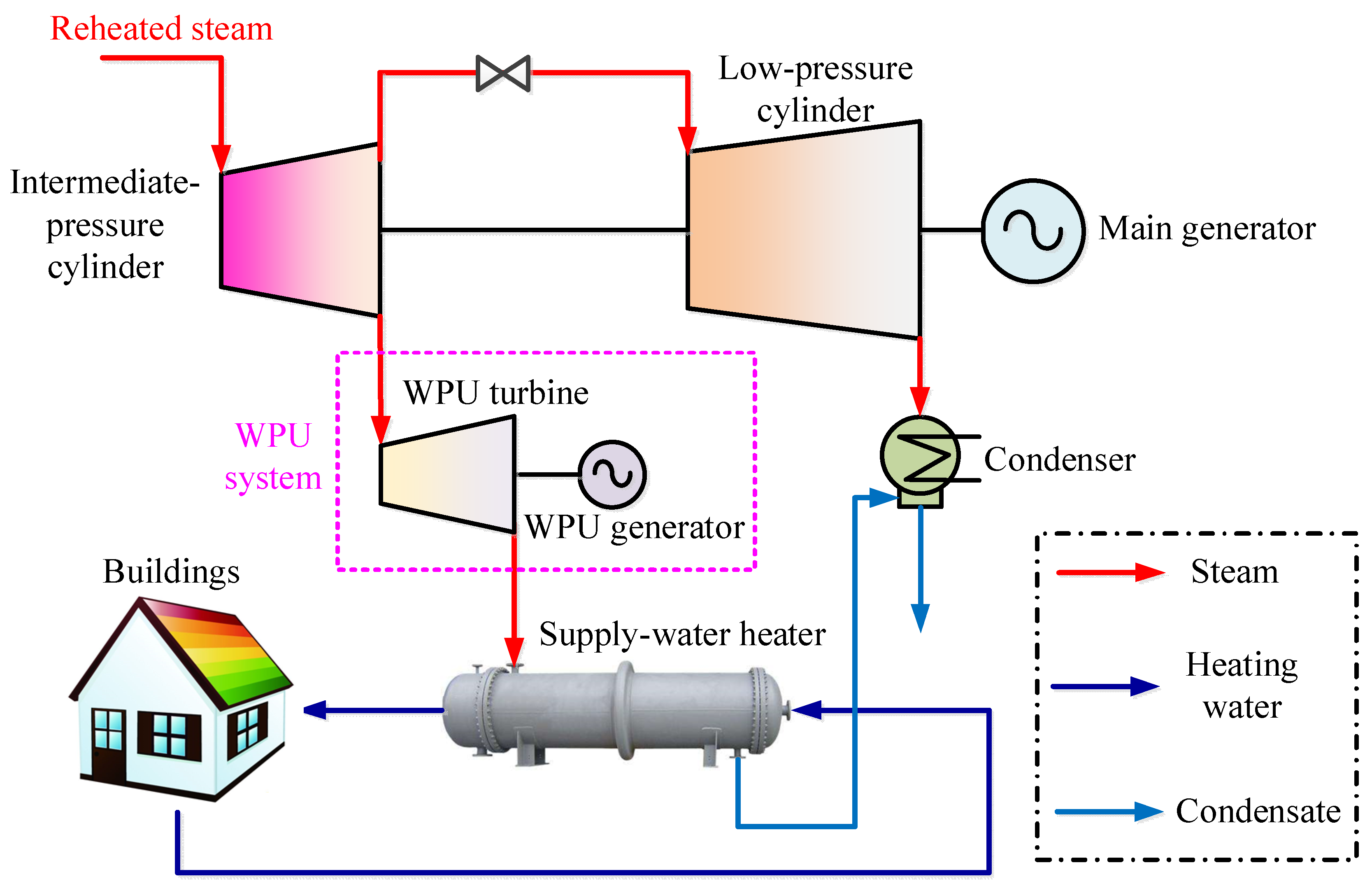
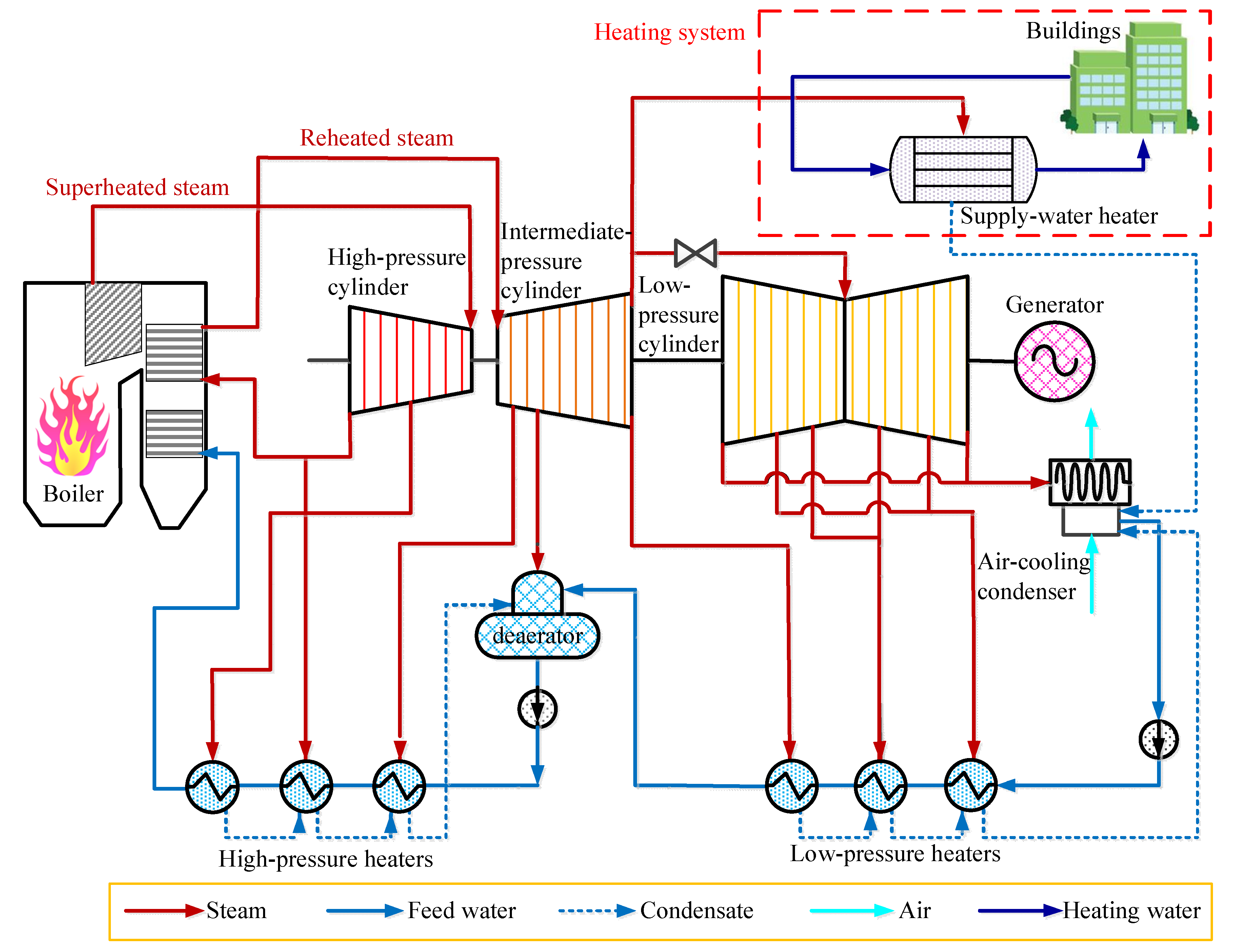
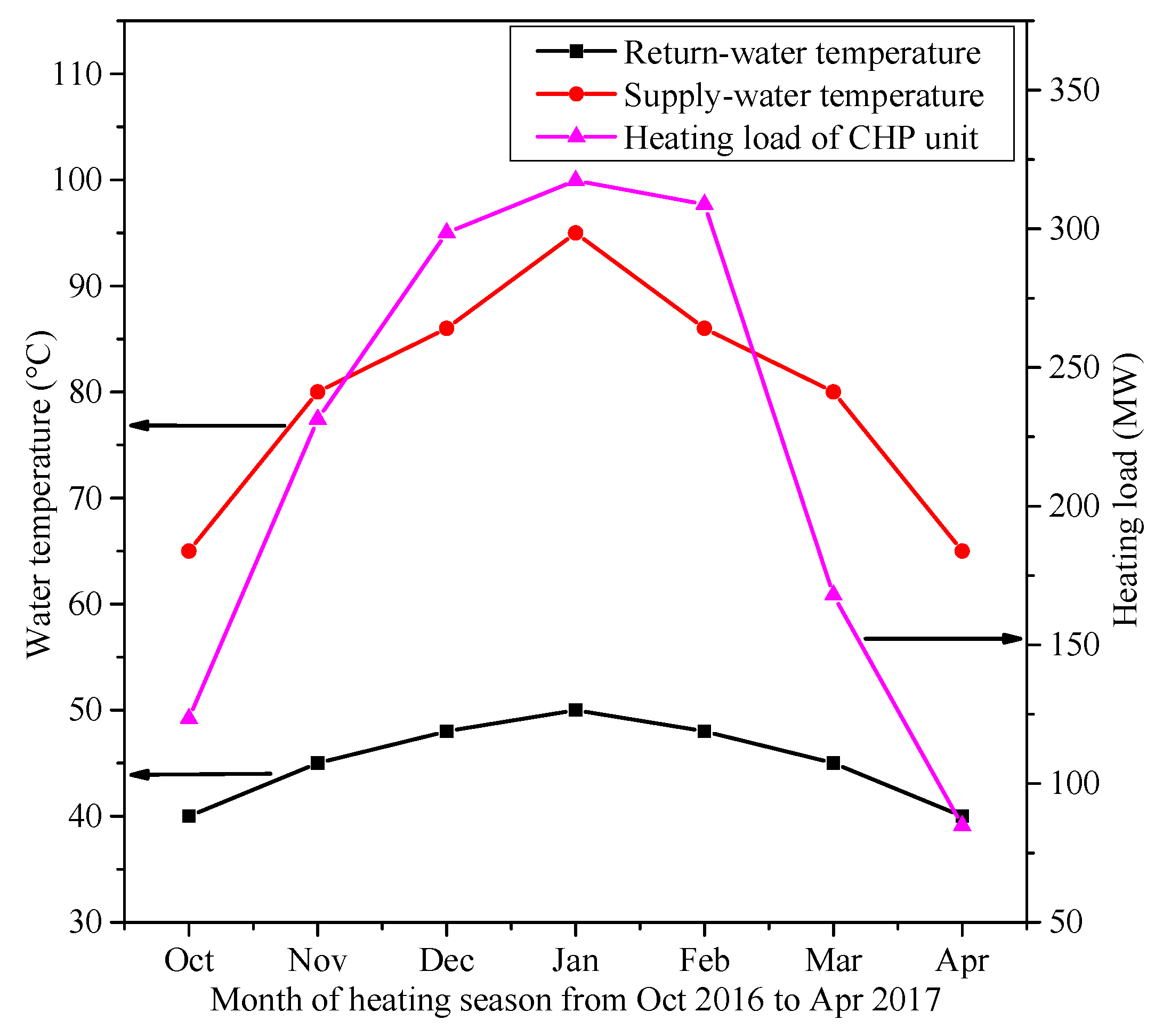
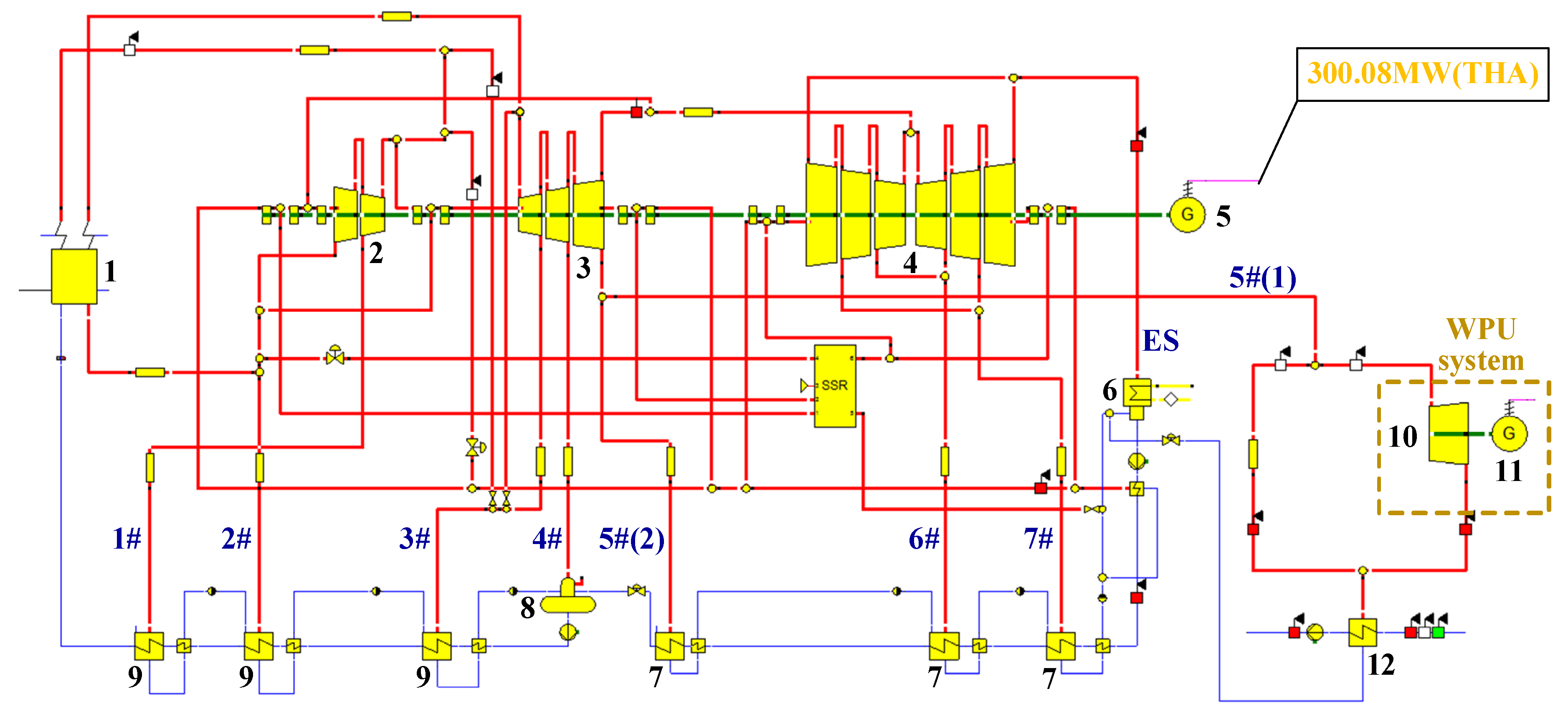
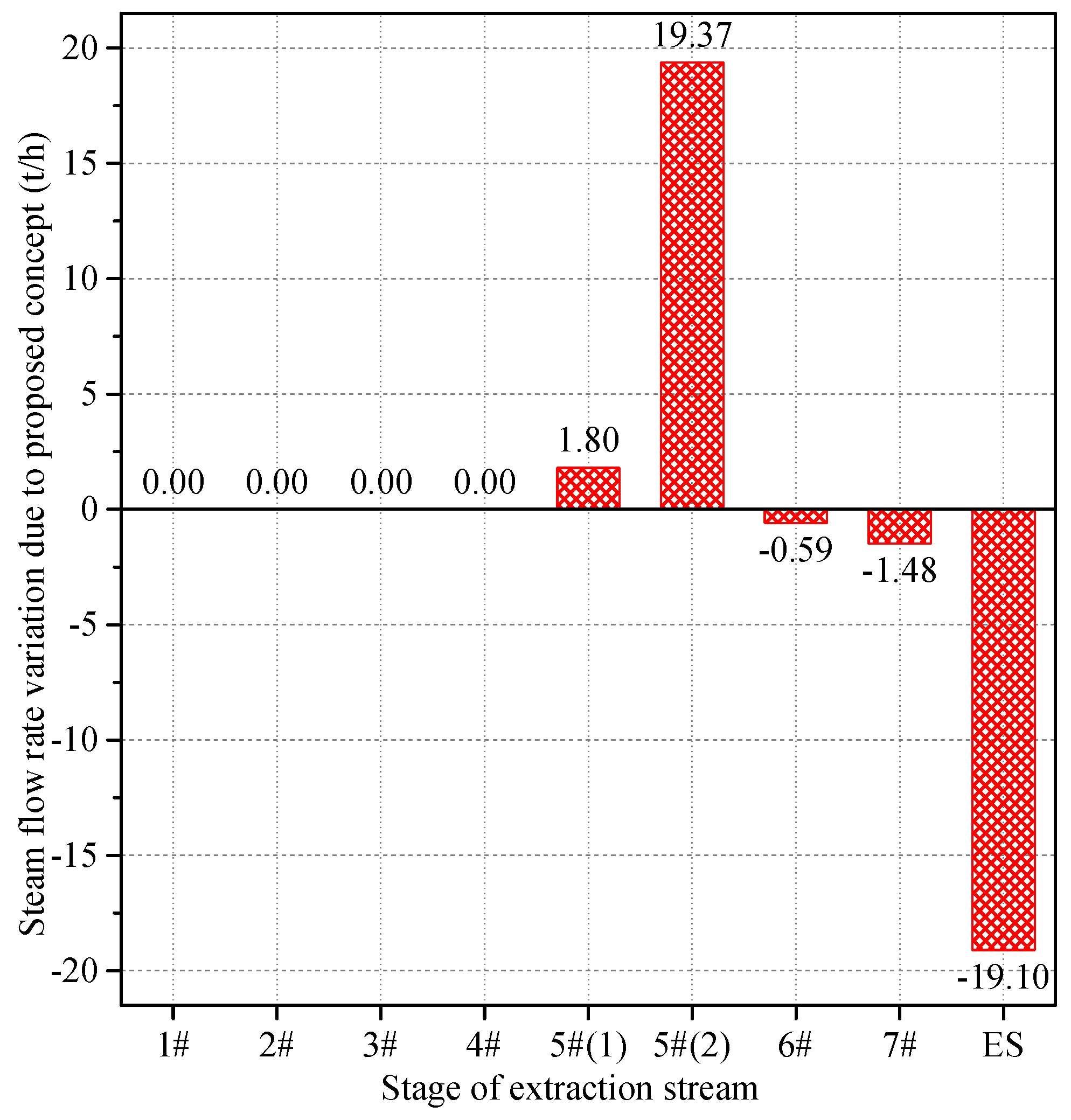
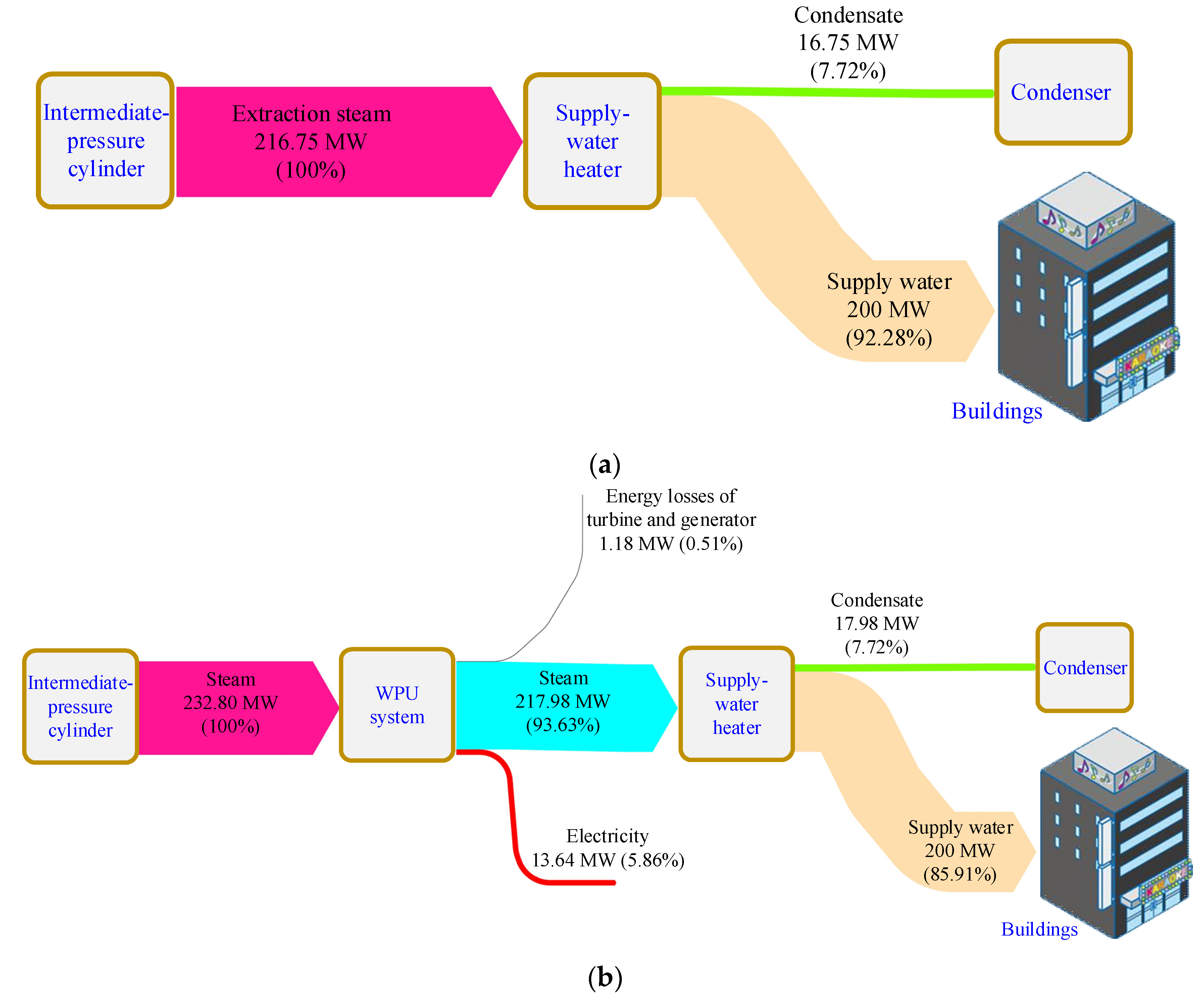
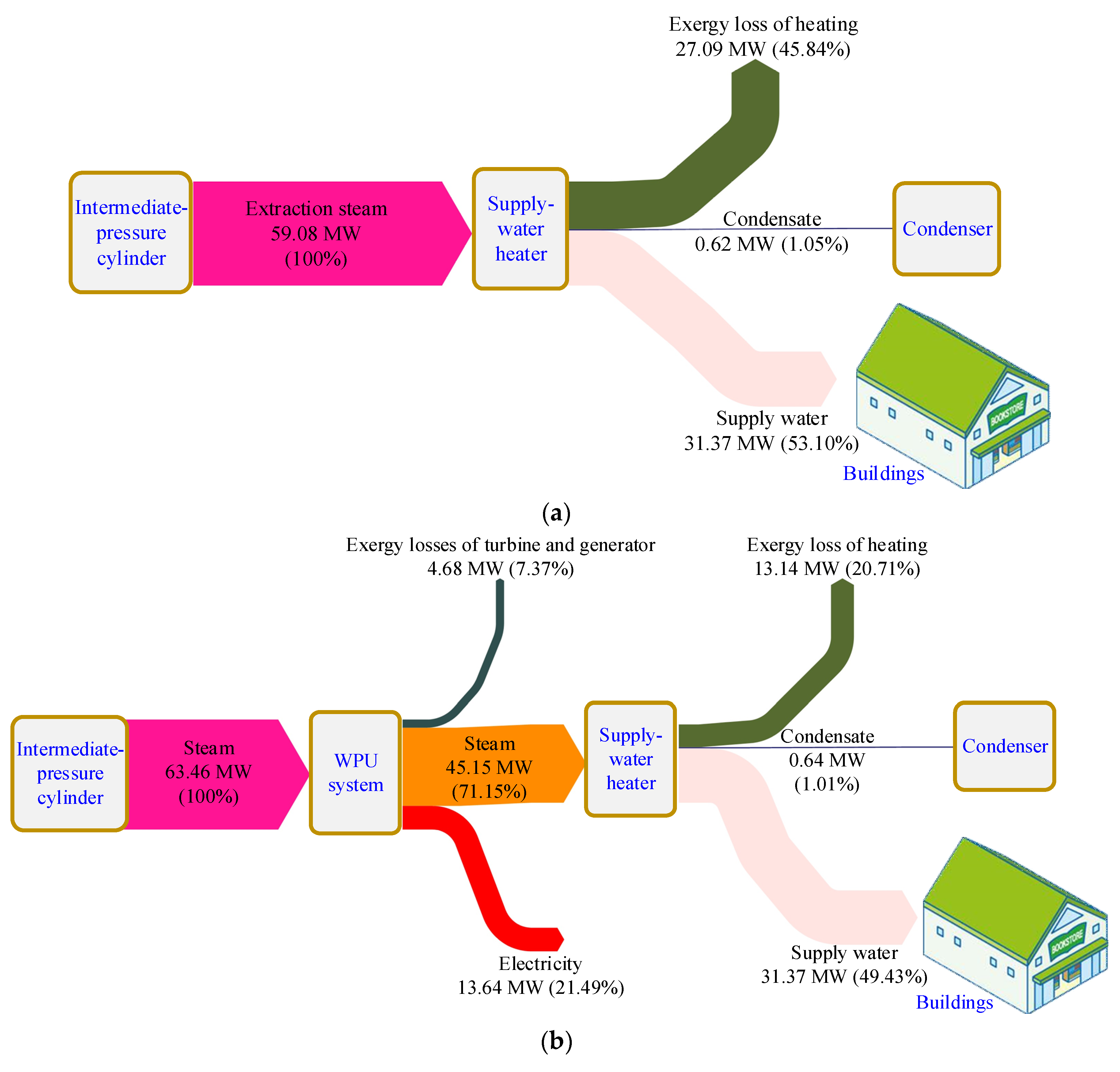
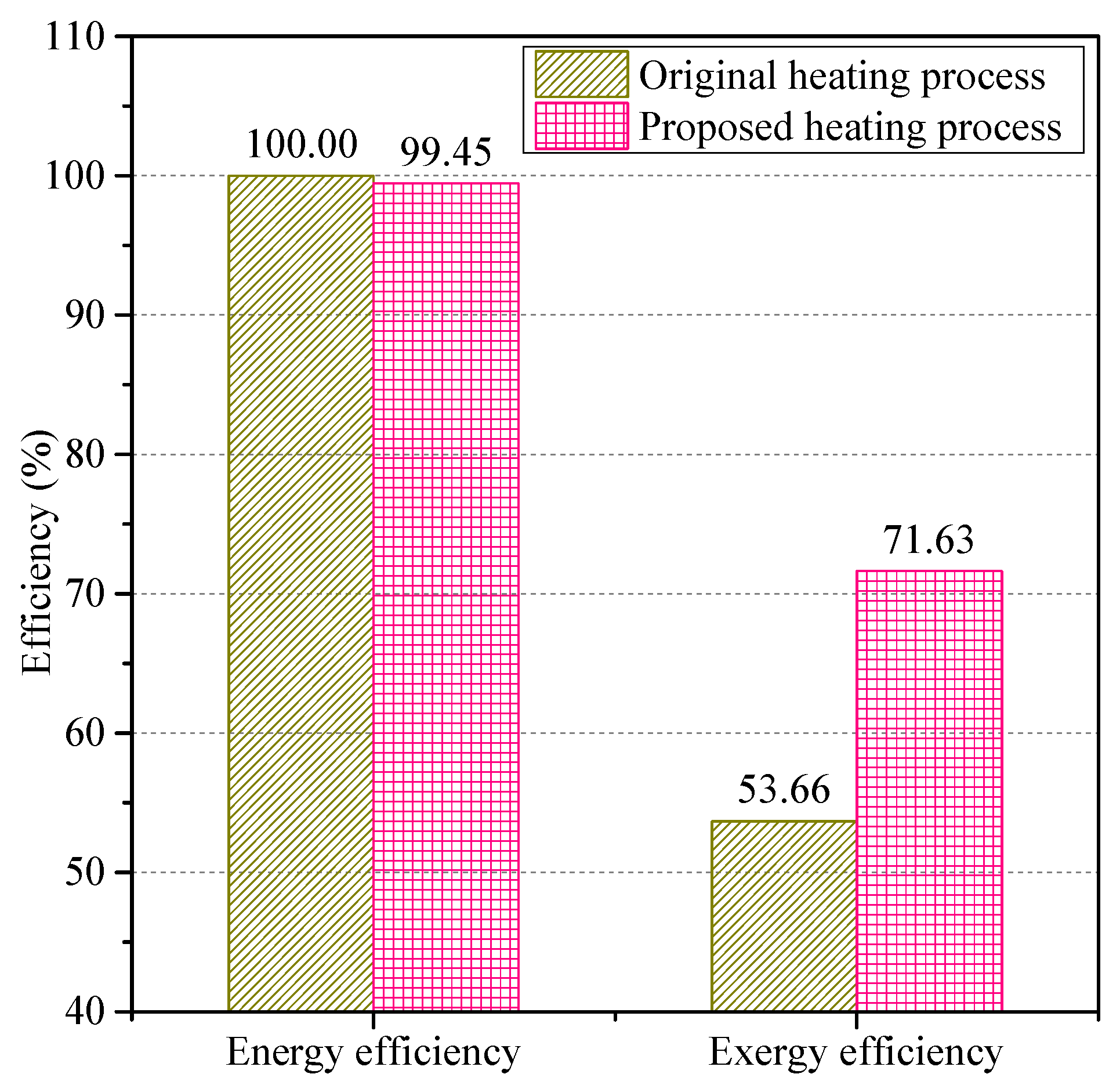

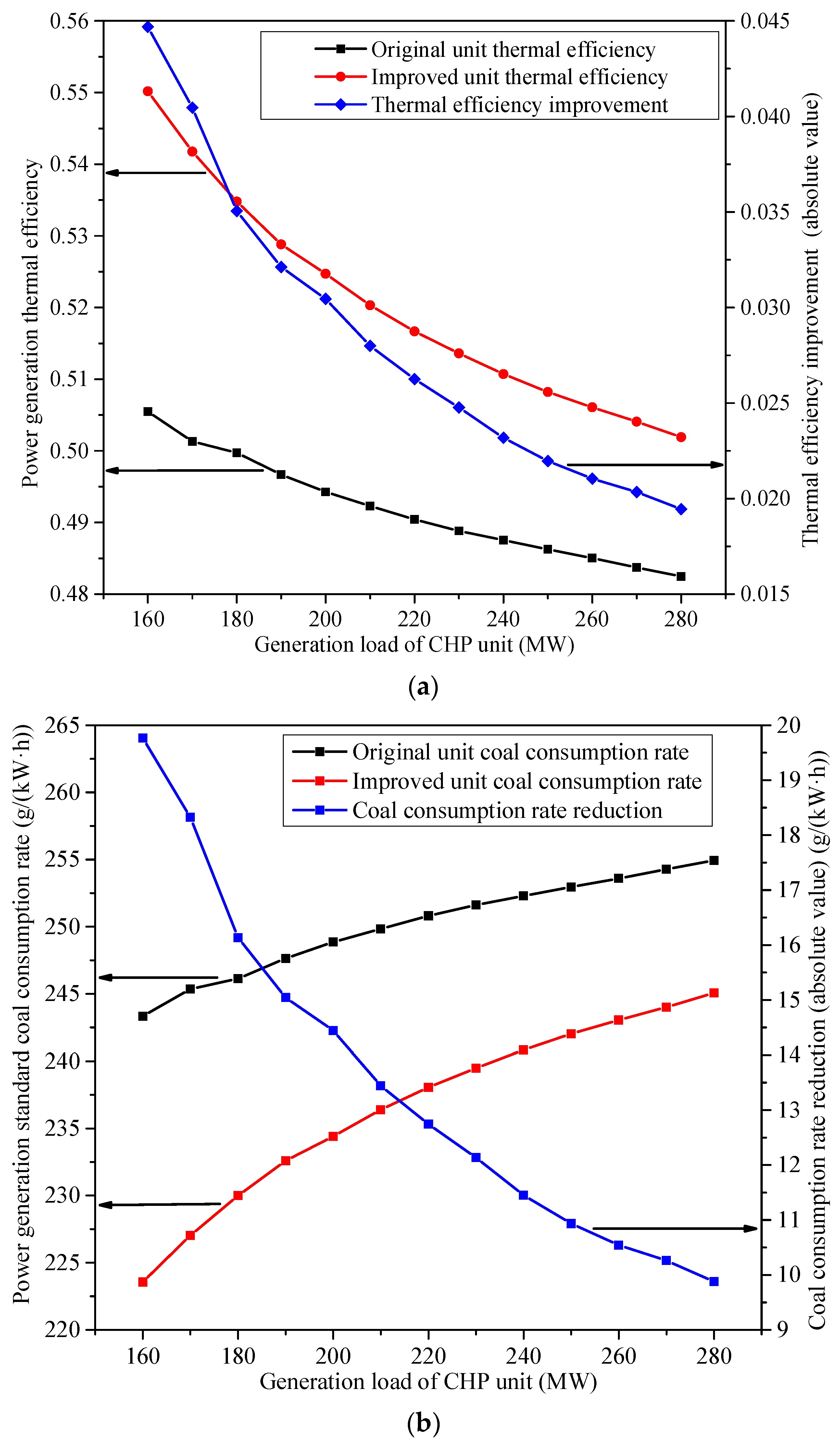
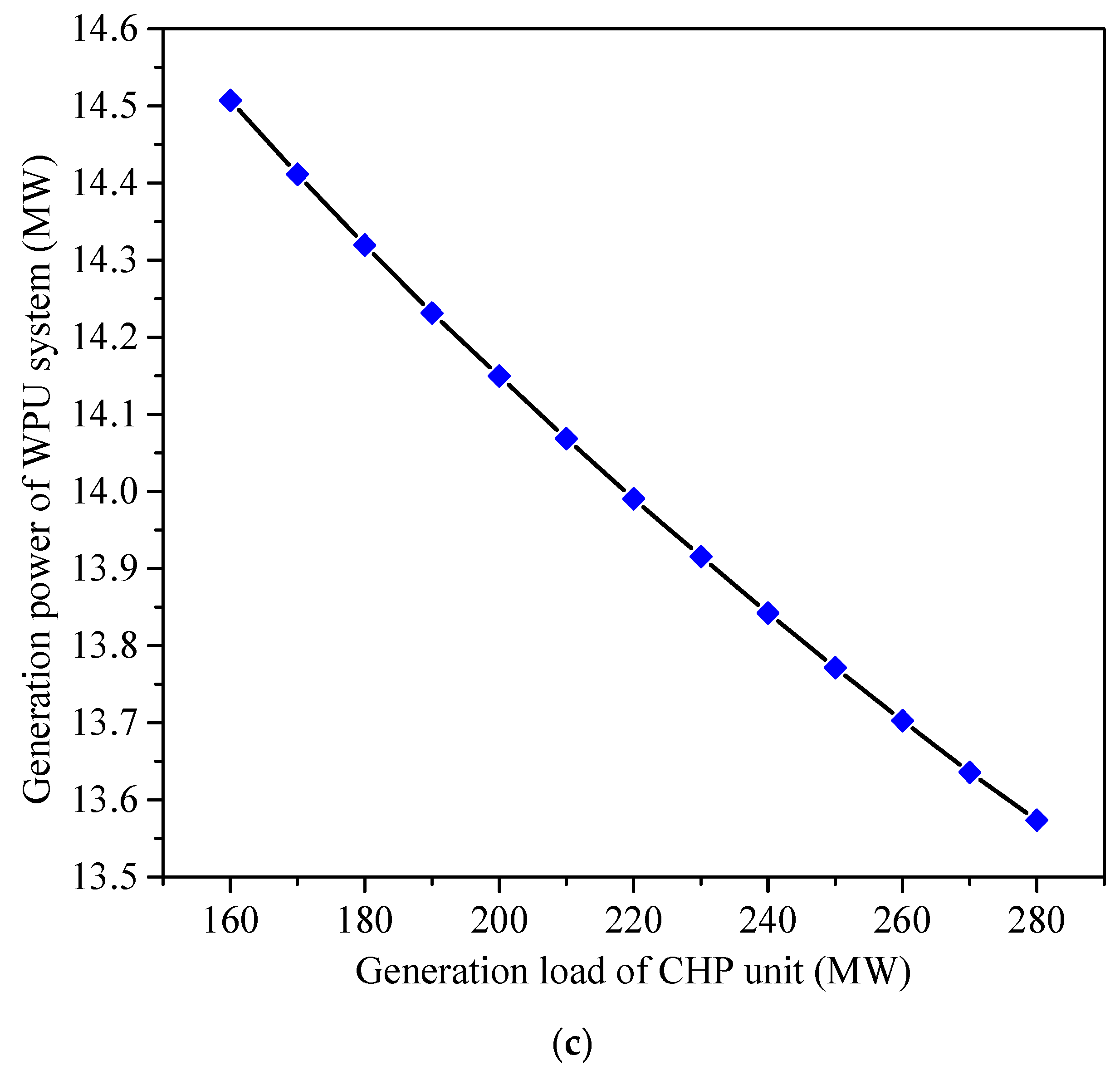
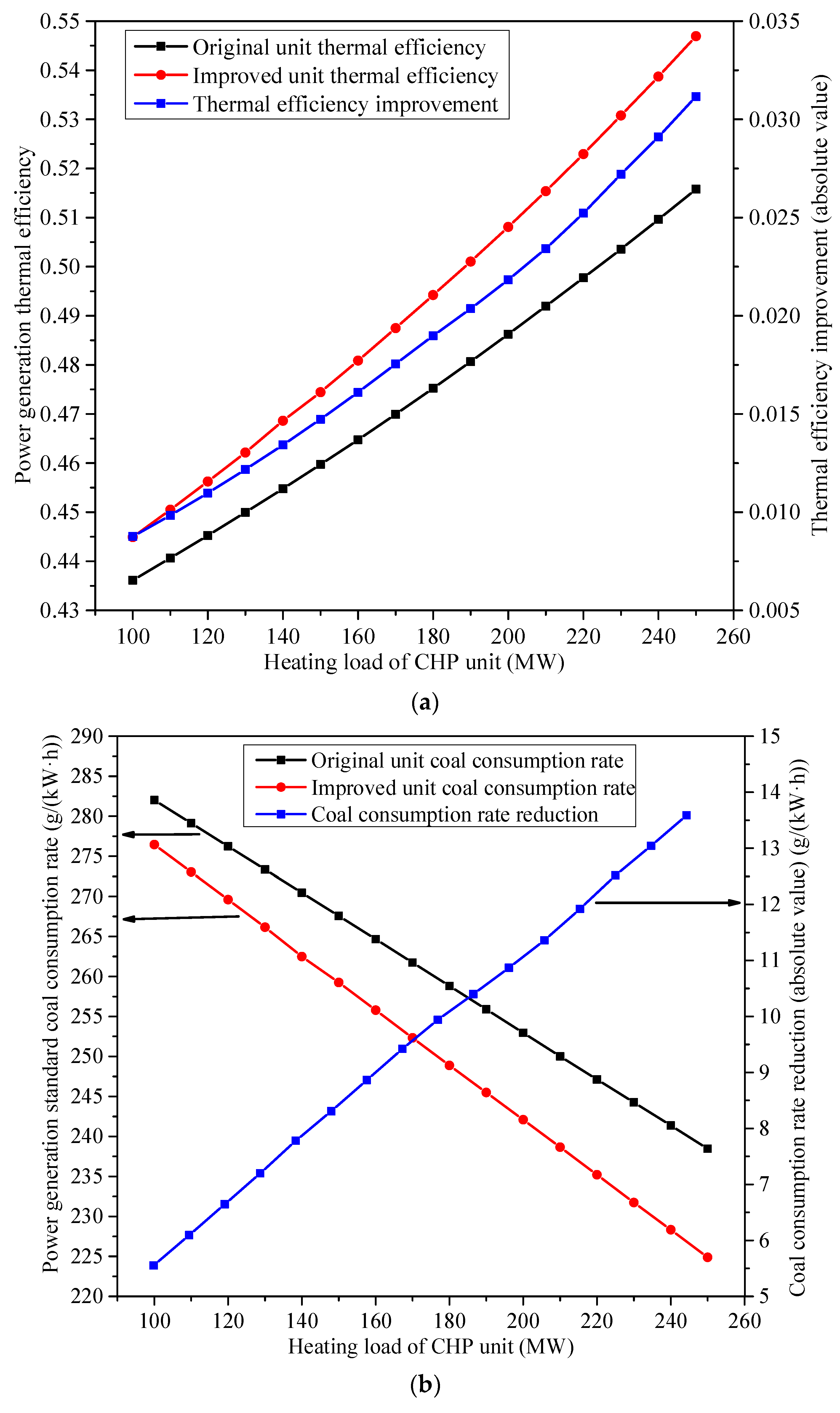
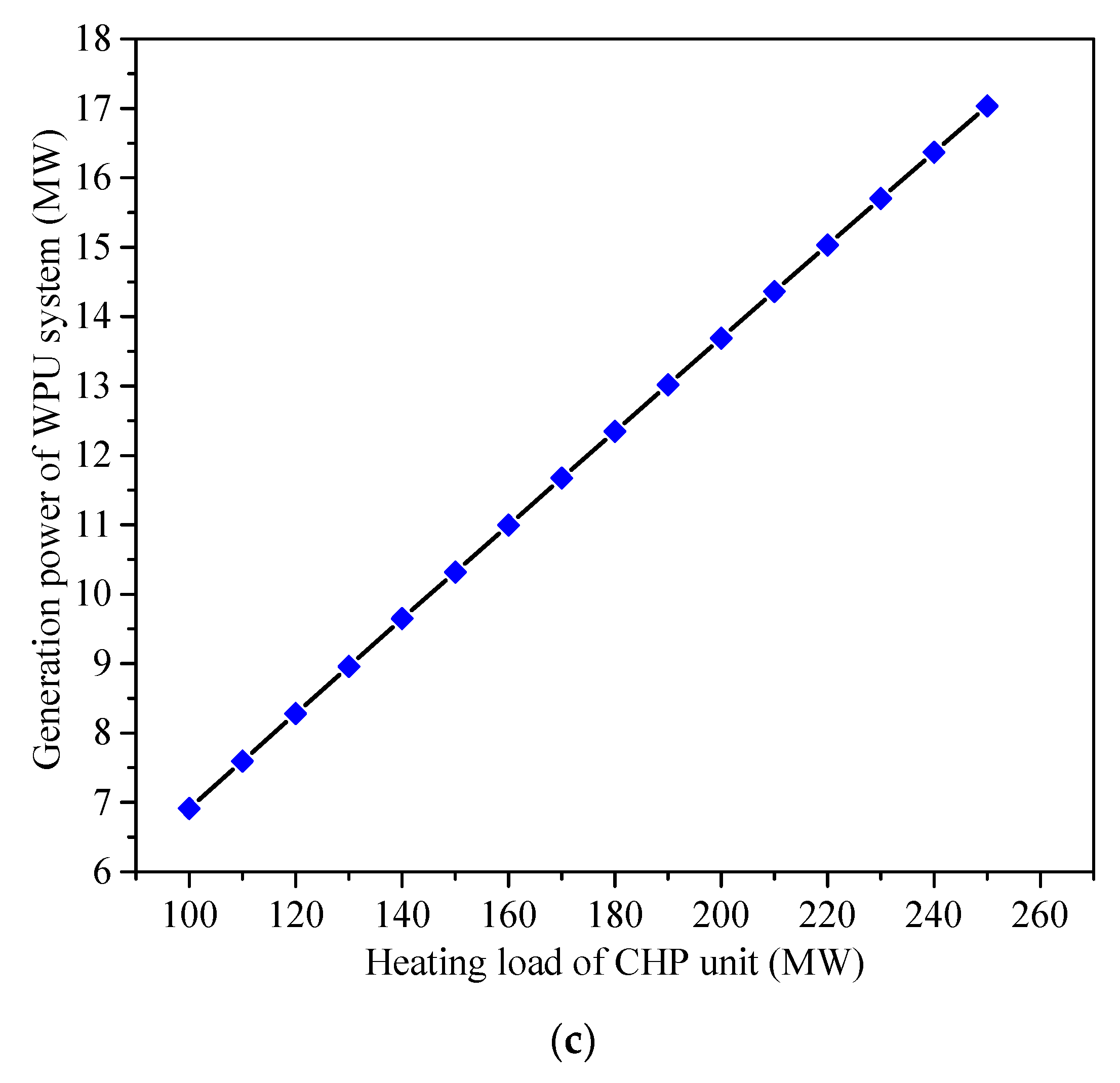
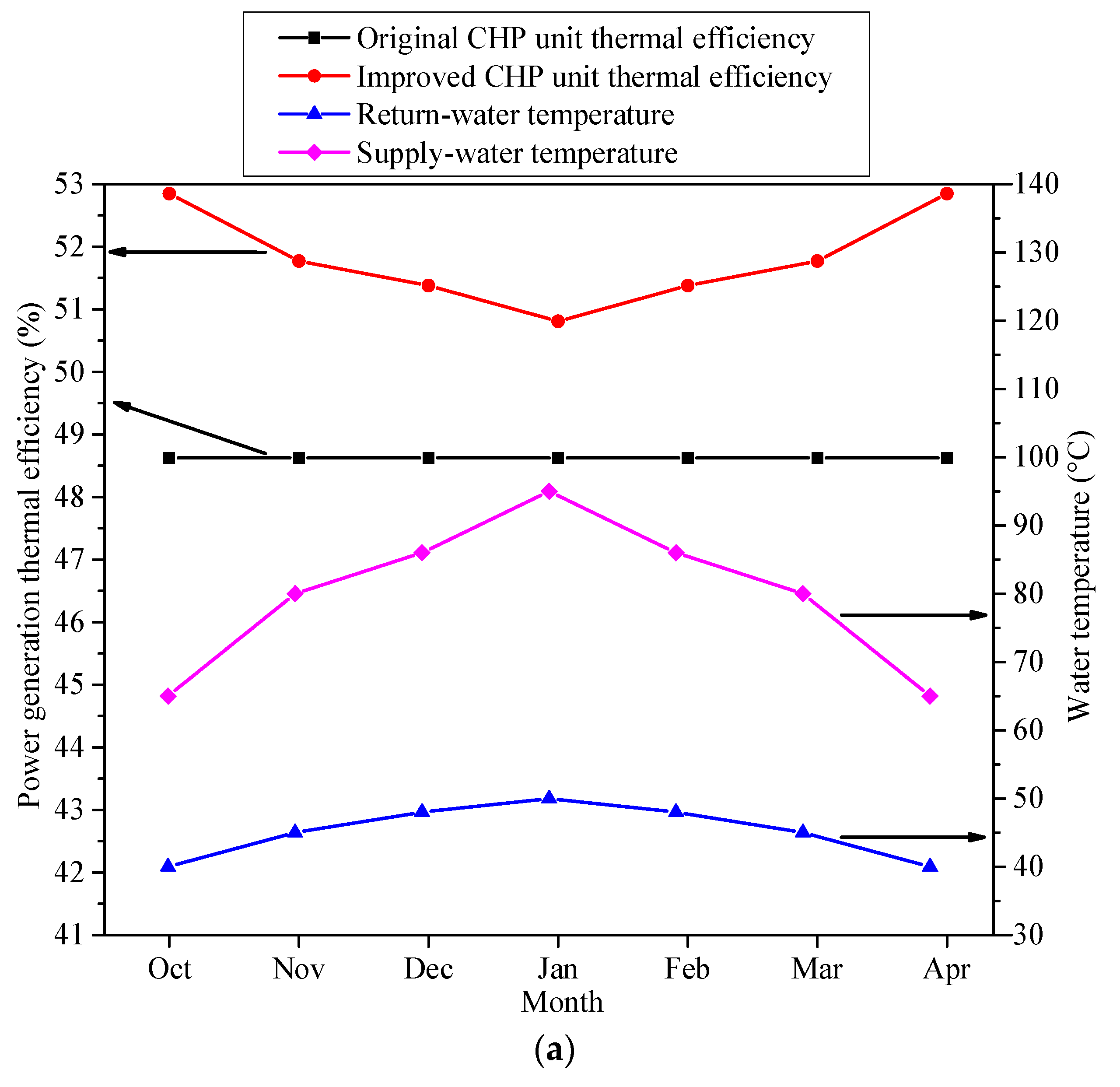
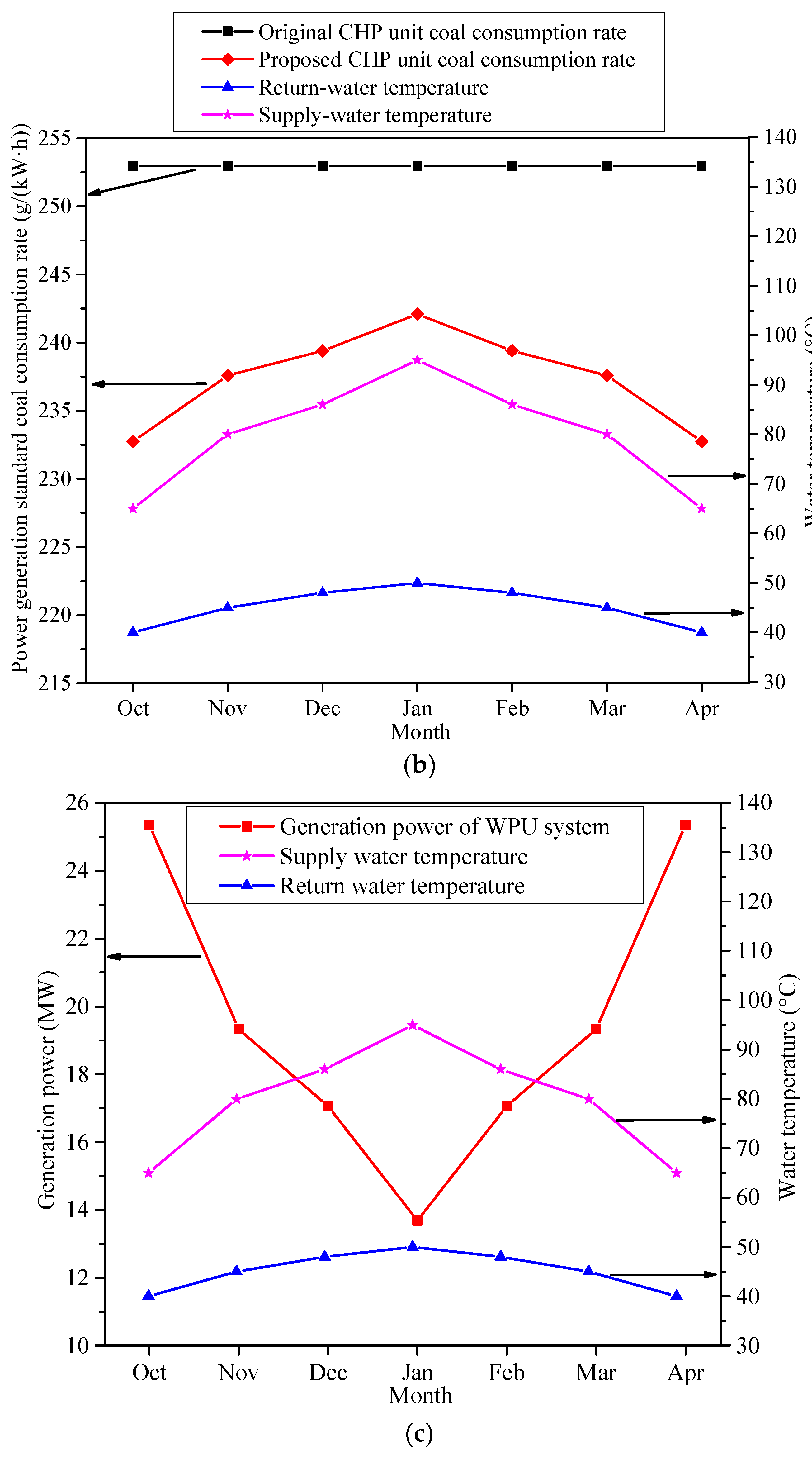
| Parameter | Unit | Value |
|---|---|---|
| Flow rate of the main steam | t/h | 906.42 |
| Pressure of the main steam | MPa | 16.67 |
| Temperature of the main steam | °C | 538 |
| Flow rate of the reheated steam | t/h | 755.98 |
| Pressure of the reheated steam | MPa | 3.16 |
| Temperature of the reheated steam | °C | 538 |
| Exhaust steam flow rate of the low-pressure cylinder | t/h | 346.30 |
| Exhaust steam pressure of the low-pressure cylinder | kPa | 14 |
| Pressure of the extracted heating steam from the intermediate-pressure cylinder | MPa | 0.40 |
| Flow rate of the extracted heating from the intermediate-pressure cylinder | t/h | 261.66 |
| Designed temperature of the condensate from the heating steam | °C | 104 |
| Actual temperature of the condensate from the heating steam | °C | 55 |
| Heating load of the CHP unit | MW | 200 |
| Generation load of the CHP unit | MW | 250 |
| Designed supply-water temperature of the thermal network | °C | 130 |
| Actual supply-water temperature of the thermal network | °C | 95 |
| Designed return-water temperature of the thermal network | °C | 70 |
| Actual return-water temperature of the thermal network | °C | 50 |
| Power generation thermal efficiency of the CHP unit | % | 48.62 |
| Power generation standard coal consumption rate of the CHP unit | g/(kW·h) | 252.96 |
| Item | Unit | Value | |||
|---|---|---|---|---|---|
| Supply-water temperature | °C | 95 | 86 | 80 | 65 |
| Return-water temperature | °C | 50 | 48 | 45 | 40 |
| Pressure of the extraction steam from the intermediate-pressure cylinder | MPa | ≥0.40 | ≥0.40 | ≥0.40 | ≥0.40 |
| Theoretical lowest heating steam pressure needed by the supply-water heater 1 | MPa | 0.12 | 0.09 | 0.07 | 0.04 |
| Theoretical pressure loss | MPa | ≥0.28 | ≥0.31 | ≥0.33 | ≥0.36 |
| Operation Condition | Practical Value (MW) | Calculated Value (MW) | Relative Error (%) |
|---|---|---|---|
| THA | 300.23 | 300.08 | −0.05 |
| 75% THA | 225.10 | 225.72 | +0.27 |
| 50% THA | 150.06 | 150.40 | +0.23 |
| 40% THA | 120.07 | 120.71 | +0.54 |
| 30% THA | 90.06 | 90.75 | +0.77 |
| Item | Original Unit | Improved Unit | Difference 1 (Absolute Value) |
|---|---|---|---|
| Main steam flow rate (t/h) | 906.42 | 906.42 | 0 |
| Flow rate of the extracted heating steam from the intermediate-pressure cylinder of the main turbine (t/h) | 261.66 | 281.03 | +19.37 |
| Heating load of the unit (MW) | 200 | 200 | 0 |
| Generation power of the main generator (MW) | 250 | 246.49 | −3.51 |
| Generation power of the WPU generator (MW) | 0 | 13.64 | +13.64 |
| Total generation load of the unit (MW) | 250 | 260.13 | +10.13 |
| Power generation thermal efficiency of the unit (%) | 48.62 | 50.59 | +1.97 |
| Power generation standard coal consumption rate of the unit (g/(kW·h)) | 252.96 | 243.12 | −9.84 |
© 2018 by the authors. Licensee MDPI, Basel, Switzerland. This article is an open access article distributed under the terms and conditions of the Creative Commons Attribution (CC BY) license (http://creativecommons.org/licenses/by/4.0/).
Share and Cite
Chen, H.; Xu, J.; Xiao, Y.; Qi, Z.; Xu, G.; Yang, Y. An Improved Heating System with Waste Pressure Utilization in a Combined Heat and Power Unit. Energies 2018, 11, 1515. https://doi.org/10.3390/en11061515
Chen H, Xu J, Xiao Y, Qi Z, Xu G, Yang Y. An Improved Heating System with Waste Pressure Utilization in a Combined Heat and Power Unit. Energies. 2018; 11(6):1515. https://doi.org/10.3390/en11061515
Chicago/Turabian StyleChen, Heng, Jidong Xu, Yao Xiao, Zhen Qi, Gang Xu, and Yongping Yang. 2018. "An Improved Heating System with Waste Pressure Utilization in a Combined Heat and Power Unit" Energies 11, no. 6: 1515. https://doi.org/10.3390/en11061515
APA StyleChen, H., Xu, J., Xiao, Y., Qi, Z., Xu, G., & Yang, Y. (2018). An Improved Heating System with Waste Pressure Utilization in a Combined Heat and Power Unit. Energies, 11(6), 1515. https://doi.org/10.3390/en11061515





